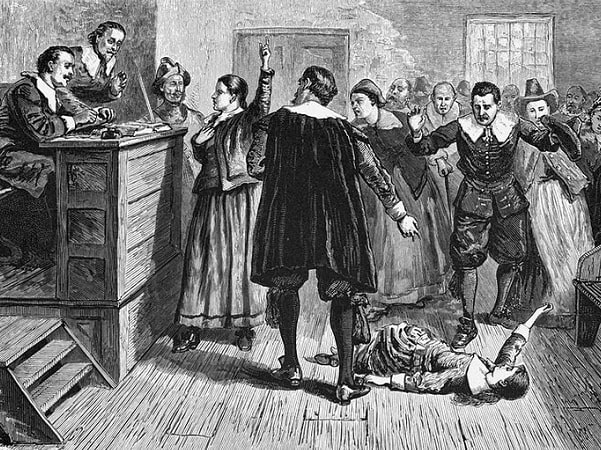Introduction: In this article, Melissa Davenport Berry writes more about the Salem witch trials of 1692, focusing again on two famous pieces of furniture: the Osborn chest and the Trask chest. Melissa is a genealogist who has a blog, AnceStory Archives, and a Facebook group, New England Family Genealogy and History.
Today I continue with the relics of the Salem Witch Trials. Many of these objects have been on exhibit at the Peabody Essex Museum (PEM) in Salem, Massachusetts.

To recap: My last story provided an introduction to the Osborn family chest, attributed to the James Symonds joinery shop in Salem. This chest is associated with a similar one known as the Trask chest. Both are purported to have been owned by the Trask family, who married into the Osborn family lines.
The below photo of the Trask chest appeared in Benno M. Freman’s article “The Osborne Family Chest Rediscovered: Historical New Hampshire,” taken via the New England Historic Genealogical Society (NEHGS) in 1901.

Story of the Peabody Essex Museum’s Purchase of the Osborn Chest
The New Hampshire Historical Society in Concord was gifted a large collection in 1957 from Katharine Prentis Murphy (1882-1967). Among the pieces documented in the collection was the Osborn family chest.
In October of 1983 the contents of the Prentis collection were auctioned by Robert W. Skinner. The Essex Institute (now the Peabody Essex Museum) purchased the chest for $35,000.
In his article “The Osborne Family Chest Rediscovered: Historical New Hampshire,” Benno M. Freeman determines that the last family members to have owned the chest were Lyman Perley Osborn (1860-1933) and his first wife (also a cousin), Elizabeth Cheever Osborn (1858-1914), daughter of Louis Osborn and Eliza Sutton Cheever.
I found Elizabeth’s obituary, published on 14 February 1914, in the Boston Public Library Archives.
In his article, Freeman cites a reference to the Osborn chest recorded in Sydney Perley’s The History of Salem, Massachusetts, Volume 1.
The chest bears an inscription – “Hannah Osborne 1831” – on the underside of the lid, which indicates that the chest came down from Caleb Osborn (1760-1827) and his wife Hannah Trask (1766-1844).
Lyman and Elizabeth directly descend from Caleb and Hannah. Read more below.
Quaker Ties
An article by Martha H. Willough entitled Patronage in Early Salem: The Symonds Shops and Their Customers, published in “American Furniture 2000,” also provides a provenance for the Osborn chest.
Willough cites the Quaker ties associated with Salem families (Pope, Buffington, Osborn, Trask) who commissioned pieces from the Symonds shop in Salem. See: Early Quaker Meetings Raided by Salem Authorities.
Other Quaker families closely affiliated through marriage were Southwick, Burton, Buffum, Shattuck, and Phelps.
To trace the provenance of the Osborn chest as well as the Quaker lines associated with it, it is best to show the connection Lyman and Elizabeth share – more specifically, Caleb Osborn (son of John Osborn and Anna Purrington) and Hannah Trask (daughter of Amos Trask and Hannah Goldthwaite).
In her article, Willough states:
The Osborne family had ties to the Quaker community through William Osborne’s (1640–1729) wife, Hannah Burton (1640–1721), and their children’s marriages. During the 1660s, Hannah was fined for not attending a recognized church, as was her father, Captain John Burton (d. 1684), and brother John (b. 1640). Her father accompanied Lawrence and Cassandra Southwick’s son Josiah (1632–1693) on an exploratory journey to Rhode Island during the beginnings of Quaker persecution in 1657. The Osborne family’s relationship with the Southwicks continued through the late 1600s and early 1700s with the marriages of William and Hannah’s sons Samuel and John to sisters Eleanor (1674–1702) and Mercy (b. 1676) Southwick, daughters of Daniel Southwick (1637–1719) and granddaughters of Lawrence and Cassandra. Like his brother Josiah, Daniel Southwick adhered to his parents’ Quaker beliefs and was fined throughout the 1660s. [Court records for Quakers can be viewed here: University of Virginia.] William and Hannah Osborne’s sons also married daughters of Joshua and Caleb Buffum. [See: Buffum Bible.] After Mercy Southwick’s death, John Osborne married Hannah Buffum (b. 1677), daughter of Caleb Buffum, and Samuel Osborne’s daughter, Elizabeth (b. 1699), married Joshua Buffum (b. 1681), eldest son and namesake of the defiant Quaker carpenter.
Explore over 330 years of newspapers and historical records in GenealogyBank. Discover your family story! Start a 7-Day Free Trial
Note on the header image: witchcraft trial at Salem Village. The central figure in this 1876 illustration of the courtroom is usually identified as Mary Walcott. Credit: Wikimedia Commons.
Related Articles:
- Witchcraft: Salem Witch Trials
- Witchcraft: Salem Witch Trials, Part 2
- Salem Witchcraft (part 1)
- Salem Witchcraft (part 2)
- Relics of the Salem Witch Trials Era (part 1)
- Relics of the Salem Witch Trials Era (part 2)
- Relics of the Salem Witch Trials Era (Part 3)
- Relics of the Salem Witch Trials Era (part 4)
Further Reading:
- Quaker Letter from 1660 Reveals Troubled Time.
- A well-documented source to consult in research on Salem Quaker families is Neighbors, Friends, or Madmen: The Puritan Adjustment to Quakerism in Seventeenth-Century Massachusetts Bay, Jonathan M. Chu.
- The Katharine Prentis Murphy Collection from the New Hampshire Historical Society, R.W. Skinner.
- “The Prentis Collection,” Philip M. Guyol, Historical Society New Hampshire, December 1958, Fig. 4. Accession #1957.65.25.
- Note: A letter dated 14 February 1968, written by Eleanor Spofford Perley (1894-1974), daughter of author and historian Sidney Perley and Harriet Hood Spofford, provided evidence of the provenance of the Osborn chest. See: Perley Family Papers PEM Library. After Elizabeth’s death Lyman P. Osborn married Dorothea Clement Sawtell, daughter of Calvin Sawtell and Emily Colby Whittier.
